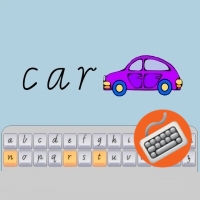
 |
Make A Word |
Make A Word is a fantastic activity for children learning the letters of the alphabet. It also reinforces the concept that letters, when placed together, make words; and those words have meaning. Simple graphics and an easy to navigate design make this a game children will love to play again and again.
The screen is made up of the main display area and the keyboard. The letters on the keyboard will appear in alphabetical order, but can be changed to a QWERTY keyboard and back again at any time. Letters can also be switched between upper and lower case.
The letters keys that can be chosen will appear orange in colour. Letters are selected until a word is formed and then a picture of the word appears. The word is then spoken and its picture appears. Each letter is named as it is chosen and the word is stated when completed.
To exit, click on the small hand on the red button in the upper right corner of the screen.
Outcome 1: Children have a strong sense of identity
Outcome 4: Children are involved and confident learners
Outcome 5: Children are effective communicators
Letters of the alphabet
QWERTY keyboard layout
Upper and lower case letters
Understanding that letters make words
Listening skills
Observation skills
Decision-making
Free play
Mouse control - single click
This activity has been designed so children can have fun using letters of the alphabet to make words. They do not need to know how to read to enjoy playing this game.
Most of the completed words are of three letters, but there are some longer words to be made.
Using the ABC layout on the screen keyboard helps to reinforce alphabet sequencing. This is great for children who are just starting to learn their letters. When children are confident with letter recognition, mix up the letters by changing to the screen QWERTY keyboard. Use both the upper and lower case option to foster familiarity and confidence with both forms of the letters. Discuss when each type is used, such as upper case at the start of people's names.